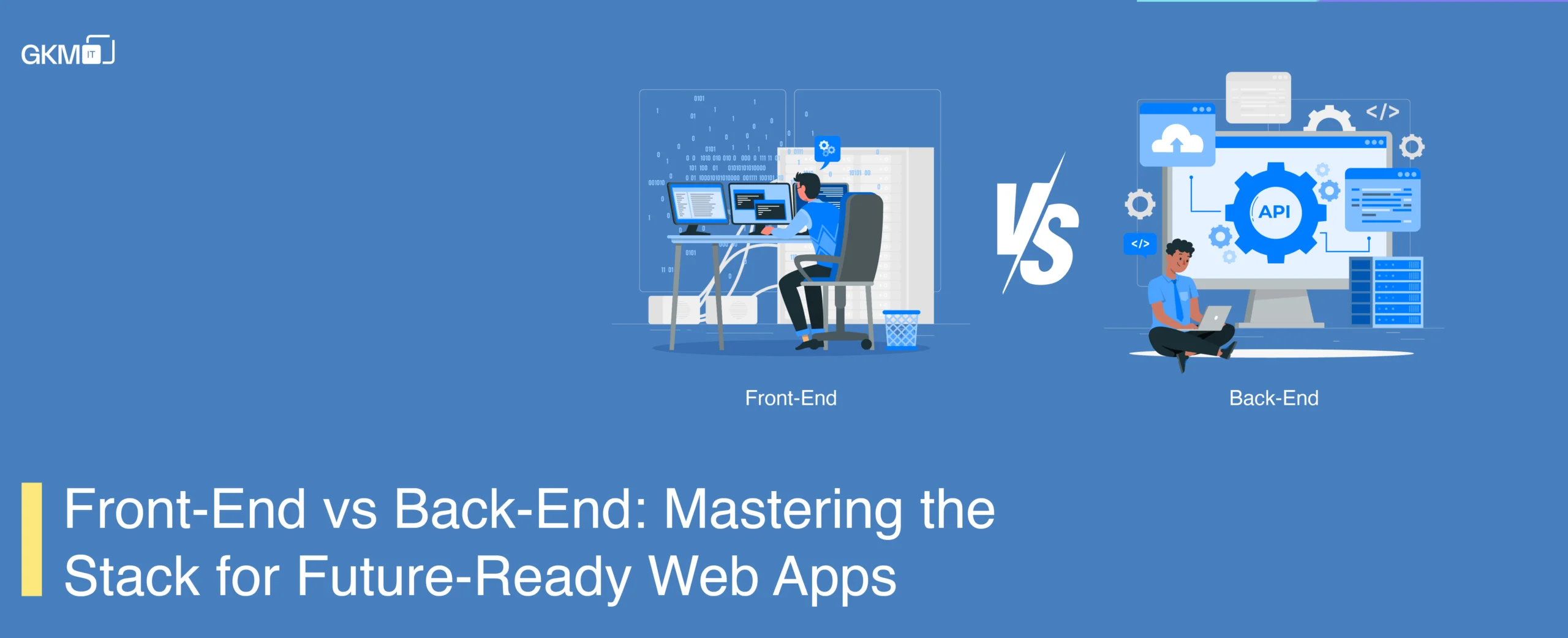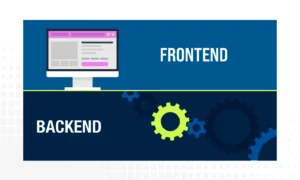
Understanding Front-End and Back-End: The Pillars of New Age Web Development
In today’s digital-first world, a website or application isn’t just a touchpoint; it is your storefront, your service delivery point, and your brand experience combined. So, to ensure it functions optimally and looks great, you’ve got two main pieces to fit together: front-end and back-end development.
If you’ve wondered why some websites are fast and intuitive and others are slow and frustrating, it’s all about the front-end vs back-end development relationship. And if you’re looking for an expert partner to bring both worlds together, GKM IT is here to help.
What is Front End Web Development?
Front end web development is the part of a website or application that people interact with. It is anything from front-end layouts, text styles, buttons, and animations. The tools they use are sometimes referred to as front-end technologies, such as HTML, CSS, and JavaScript, to name a few, where designers turn their ideas into a digital product.
However, developing on the front end today has become even more complicated. With the emergence of front-end frameworks, such as React, Angular, Vue.js, and Svelte, modern user interfaces have become interactive and immersive while managing state in an efficient way. Combine a front-end JavaScript library like jQuery or GSAP, and the developer can create seamless user transactions that elevate the overall digital experience.
At GKM IT, we don’t just write front end development code; we design digital journeys. We use the required programming languages and front-end languages appropriate for your project, keeping device compatibility, responsive design and visual design in mind.
What is Back-End Development?
While the front end is what the user sees as they use the application, the back end is the engine that runs the application. The back end handles databases, server-side logic, authentication, API, and business processes. The back-end development is responsible for ensuring everything works fast and securely behind the scenes.
Back-end developers, using back-end languages such as Python, PHP, Ruby, Java, and JavaScript (Node.js), are able to take your back end the distance while you expand your user base. Whether it is adding a back-end solution for large datasets, accessing data, or processing secure payments, back-end solutions are in fact the structure that allows the website to run 24/7.
At GKM IT, our back-end experts are able to build scalable back-end architectures using recommended back-end frameworks such as Django, Laravel, and Express.js. Whether you are building an enterprise-grade platform or a start-up Minimum Viable Product (MVP), we know how to architect systems that are fast, secure, and stable.
Here are few differences between frontend and backend development.
Front-End vs Back-End Development: The Core Differences

Let’s simplify the difference:
Front-end is everything the users see and the way they interact with an app: design, layout, and animations.
Back-end is everything that powers the app: the servers, the databases, and the logical reasoning.
Although front-end and back-end are very different from each other, they must work together to create a successful application. This is where full-service teams such as GKM IT excel; our front-end developers and back-end developers are coordinated and work together to create a sensible workflow from UI to database.
What Do Front-End Developers Do?
Today’s front-end developers are part designer and part engineer. Front-end frameworks allow them to build responsive, thoughtfully curated user interfaces that are responsive to every screen size. They are not only experts in code but also understand design psychology, accessibility, and usability.
Using front-end JavaScript libraries, front-end developers can rapidly prototype and build real-time interactions, animations, or components like sliders, modals, and dropdowns.
At GKM IT, our front-end team is cutting-edge. We are continuously evaluating new layouts, languages, and experiences. Our developers optimise performance, whether monitoring specific front-end languages or how these languages integrate with headless CMS platforms, while providing the high-performance front end that the end-user will and does love.
What Does a Back-End Developer Do?
There is always a strong back end behind a smooth front end. Back-end developers make sure data is delivered correctly, safely, and with speed from servers to users. They build everything from database schemas to APIs, business logic, and cloud services.
At GKM IT, our back-end team produces reliable, scalable, and secure back-end development services. Utilizing industry-leading back-end languages and back-end frameworks, we deliver appropriate back-end technologies for your project, whether it’s a microservice, REST API, or full-fledged enterprise application.
From processing payment information to user authentication, our back-end developers have provided bulletproof back-end development for your app.
Why You Need Both: Frontend and Backend Collaboration

Building an app without coordination between Frontend and Backend is like building a car with a beautiful body, and no engine, or an engine with no dashboard.
The reality is, frontend vs backend web development isn’t a competition. It’s a collaboration. Your front-end programming language must flow with the backend language through APIs. For a smooth working dynamic, the Frontend and Backend languages must connect. Your UI/UX will depend on the visual interface (front-end) and equally on the speed and reliability of the data (back-end).
At GKM IT, our cross-functional teams work together from day one. Whether it’s architecture alignment, IT and devops alignment, defining our endpoints, or collaborative delivery pipelines, we ensure your entire app works smoothly, from interface to infrastructure, and is built as one complete unit.
Picking the Right Stack
Choosing the right stack is not just about picking programming languages or libraries; it’s about selecting a strategy. Should you use React or Vue? Should you select Django or Node.js?
Here is how GKM IT helps you choose:
- For the Front End: We review your project goals, audience, and scalability to select the perfect front-end programming language and frameworks.
- For the Back End: We select your best-fit back-end programming language and frameworks to support performance, security, and integration.
Our team thinks about your team’s skills, timelines, and post-launch maintenance. Whether you want a monolithic build or microservices, we will ensure your technology supports your business long-term.
New Trends in Front End and Back End Development
Things are changing quickly. The future of front-end and back-end development is more collaborative, integrated, and automated than ever.
With full-stack frameworks like Next.js, the lines are even further blurred with front-end frameworks calling API’s. Serverless and headless architecture blend the definition of frontend vs. backend even more.
JAMstack, edge computing, and composable architecture continuously shape and change the definition of frontend vs. backend web development.
At GKM IT, we are not just following the trends; we implement them. Whether you are coming to us for a headless CMS, cloud-native applications, or serverless APIs, we have a depth of knowledge to provide you with leading-edge capabilities that scale.
Conclusion: Selecting GKM IT as Your Development Partner
If you are launching, redesigning, or scaling your digital product, it is crucial to find suitable development partners. GKM IT brings great front-end and back-end development together to deliver full-cycle digital services.
We combine:
- Pixel-perfect front-end developers who create beautiful, high-performing user interfaces.
- Expert back-end developers who create scalable, secure, and fast infrastructures.
- A collaborative environment that measures success by ensuring that your Frontend and Backend languages work together.
- Strategic thinking to help select the right front-end frameworks, backend frameworks, and languages for your business goals.
GKM IT is your trusted technology partner – whether you’re a startup building your MVP or an enterprise modernizing your legacy systems.
Ready to Develop Your Ideal Application?
Contact us at GKM IT to get started on your next web or mobile project. We are ready to help turn your ideas into powerful digital experiences with our front-end and back-end development expertise.
Related Blogs:
Frequently Asked Questions
1. What is the difference between front-end and back-end development?
The main difference between front-end and back-end development lies in what users see and how the system works behind the scenes.
Front End Web Development focuses on the user interface — everything you see on a website, such as layouts, colors, buttons, and navigation.
Back-end development, on the other hand, deals with the server, database, and application logic that make the front-end functional.
In simple terms, front-end developers create what users interact with, while back-end developers build and maintain the systems that power it. Together, they form the foundation of Frontend and Backend Web Development.
2. How do front-end and back-end developers collaborate?
Front-end and back-end developers work closely to ensure a website or application runs smoothly. The front-end team focuses on design, responsiveness, and user interaction, while the back-end team manages databases, APIs, and server-side logic.
They collaborate using tools like REST APIs, GraphQL, or JSON to exchange data between the Frontend and Backend systems. Proper communication and version control tools like Git help synchronize their work efficiently in front-end vs back-end development projects.
3. What are the primary responsibilities of a front-end developer?
A front-end developer is responsible for creating a website’s visual and interactive elements. Their key roles include:
Designing responsive web pages.
Implementing UI/UX designs using front-end programming languages.
Optimizing website performance and accessibility.
Ensuring compatibility across different browsers and devices.
They use front-end languages such as HTML, CSS, and JavaScript and often rely on a front-end JavaScript library or front-end frameworks like React, Angular, or Vue.js to deliver engaging user experiences.
4. Which languages and frameworks are commonly used in front-end development?
In Front End Web Development, developers typically use:
Languages: HTML, CSS, and JavaScript.
Front-end frameworks: React, Angular, and Vue.js.
Front-end JavaScript libraries: jQuery and Bootstrap.
These front-end languages and frameworks help developers build responsive, dynamic, and visually appealing interfaces that enhance user engagement and experience.
5. What are the key roles of a back-end developer?
A back-end developer focuses on the server-side aspects of web development. Their main responsibilities include:
Managing databases and server configurations.
Writing code to connect Frontend and Backend components.
Building APIs and integrating third-party services.
Implementing back-end solutions for data processing and security.
Back-end developers ensure that the system is stable, fast, and scalable — forming the technical backbone of every web application.
6. Which languages and frameworks are prevalent in back-end development?
Back-end developers work with a range of Back-end Languages and backend frameworks, such as:
Languages: Python, PHP, Java, Ruby, and Node.js.
Frameworks: Django, Laravel, Express.js, and Spring Boot.
These tools enable developers to build secure, high-performing back-end solutions that support seamless interaction between the front-end and back-end development layers of modern web applications.